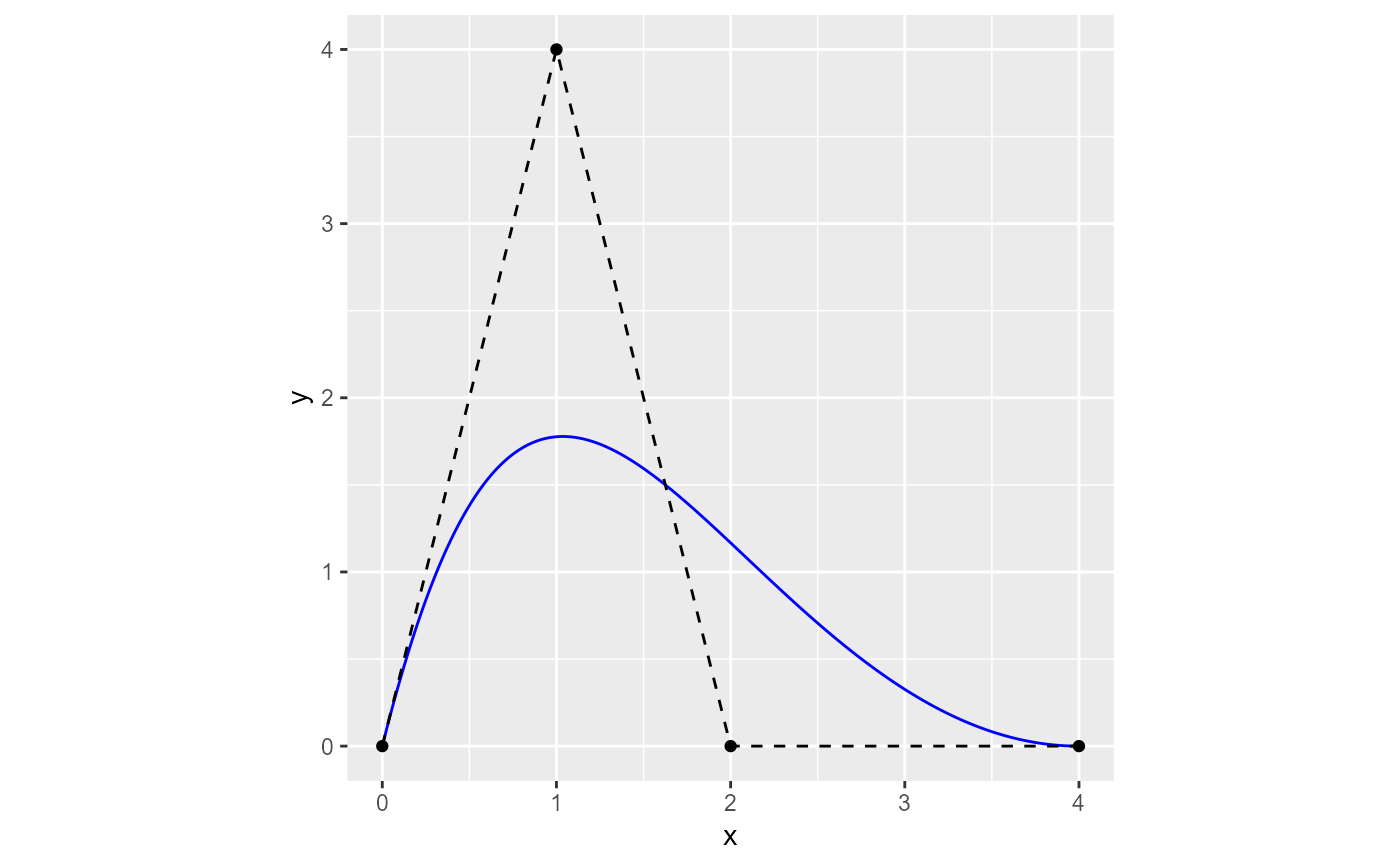The ob_bezier is specified with an ob_point object that contains at least 2 points, the start and the end. Such a "curve" would actually be a straight line segment. If three points are specified, the middle point is a control point, and a quadratic bezier curve will result. Higher-order bezier curves can be created by having more control points in the middle.
Usage
ob_bezier(
p = S7::class_missing,
label = character(0),
label_sloped = TRUE,
n = 100,
alpha = numeric(0),
arrow_head = S7::class_missing,
arrow_fins = S7::class_missing,
arrowhead_length = numeric(0),
length_head = numeric(0),
length_fins = numeric(0),
color = character(0),
fill = character(0),
lineend = numeric(0),
linejoin = numeric(0),
linewidth = numeric(0),
linewidth_fins = numeric(0),
linewidth_head = numeric(0),
linetype = numeric(0),
resect = numeric(0),
resect_fins = numeric(0),
resect_head = numeric(0),
stroke_color = character(0),
stroke_width = numeric(0),
style = S7::class_missing,
id = character(0),
...
)Arguments
- p
ob_point or list of ob_points
- label
A character, angle, or label object
- label_sloped
A logical value indicating whether the label should be sloped with the curve
- n
Number of points in a polygon, circle, arc, or ellipse
- alpha
numeric value for alpha transparency
- arrow_head
A 2-column matrix of polygon points
- arrow_fins
A 2-column matrix of polygon points
- arrowhead_length
Determines the size of the arrow ornaments. This parameter becomes the
lengthparameter in ggarrow functions. Numeric values set the ornament size relative to the linewidth. A grid::unit value sets the ornament size in an absolute manner.- length_head
Determines the size of the arrow head. Numeric values set the ornament size relative to the linewidth. A grid::unit value sets the ornament size in an absolute manner. From ggarrow.
- length_fins
Determines the size of the arrow fins. Numeric values set the ornament size relative to the linewidth. A grid::unit value sets the ornament size in an absolute manner. From ggarrow.
- color
character string for color
- fill
character string for fill color
- lineend
Line end style (round, butt, square).
- linejoin
Line join style (round, mitre, bevel).
- linewidth
Width of lines
- linewidth_fins
Line width for arrow fins
- linewidth_head
Line width for arrow fins
- linetype
type of lines
- resect
A numeric(1) denoting millimeters or grid::unit to shorten the arrow head and fins.
- resect_fins
A numeric(1) denoting millimeters or grid::unit to shorten the arrow fins
- resect_head
A numeric(1) denoting millimeters or grid::unit to shorten the arrow head.
- stroke_color
Color of point border line
- stroke_width
Stroke width in arrows
- style
Gets and sets the styles associated with ob_beziers
- id
character string to identify object
- ...
<
dynamic-dots> properties passed to style
Details
If you wish to specify multiple bezier curves, you must supply a list of ob_point objects. When plotted, the ob_bezier function uses the bezier::bezier function to create the point coordinates of the curve and the ggarrow::geom_arrow function to create the geom.
Slots
lengthThe number of curves in the ob_bezier object
tibbleGets a tibble (data.frame) containing parameters and styles used by
ggarrow::geom_arrow.geomA function that converts the object to a geom. Any additional parameters are passed to
ggarrow::geom_arrow.midpointA function that selects 1 or more midpoints of the ob_bezier. The
positionargument can be between 0 and 1. Additional arguments are passed toob_point.aestheticsA list of information about the ob_bezier's aesthetic properties

